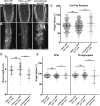The localization of PHRAGMOPLAST ORIENTING KINESIN1 at the division site depends on the microtubule-binding proteins TANGLED1 and AUXIN-INDUCED IN ROOT CULTURES9 in Arabidopsis
- PMID: 36005863
- PMCID: PMC9614452
- DOI: 10.1093/plcell/koac266
The localization of PHRAGMOPLAST ORIENTING KINESIN1 at the division site depends on the microtubule-binding proteins TANGLED1 and AUXIN-INDUCED IN ROOT CULTURES9 in Arabidopsis
Abstract
Proper plant growth and development require spatial coordination of cell divisions. Two unrelated microtubule-binding proteins, TANGLED1 (TAN1) and AUXIN-INDUCED IN ROOT CULTURES9 (AIR9), are together required for normal growth and division plane orientation in Arabidopsis (Arabidopsis thaliana). The tan1 air9 double mutant has synthetic growth and division plane orientation defects, while single mutants lack obvious defects. Here we show that the division site-localized protein, PHRAGMOPLAST ORIENTING KINESIN1 (POK1), was aberrantly lost from the division site during metaphase and telophase in the tan1 air9 mutant. Since TAN1 and POK1 interact via the first 132 amino acids of TAN1 (TAN11-132), we assessed the localization and function of TAN11-132 in the tan1 air9 double mutant. TAN11-132 rescued tan1 air9 mutant phenotypes and localized to the division site during telophase. However, replacing six amino-acid residues within TAN11-132, which disrupted the POK1-TAN1 interaction in the yeast-two-hybrid system, caused loss of both rescue and division site localization of TAN11-132 in the tan1 air9 mutant. Full-length TAN1 with the same alanine substitutions had defects in phragmoplast guidance and reduced TAN1 and POK1 localization at the division site but rescued most tan1 air9 mutant phenotypes. Together, these data suggest that TAN1 and AIR9 are required for POK1 localization, and yet unknown proteins may stabilize TAN1-POK1 interactions.
© The Author(s) 2022. Published by Oxford University Press on behalf of American Society of Plant Biologists.
Figures







Similar articles
-
Division Plane Orientation Defects Revealed by a Synthetic Double Mutant Phenotype.Plant Physiol. 2018 Jan;176(1):418-431. doi: 10.1104/pp.17.01075. Epub 2017 Nov 16. Plant Physiol. 2018. PMID: 29146775 Free PMC article.
-
Defects in division plane positioning in the root meristematic zone affect cell organization in the differentiation zone.J Cell Sci. 2022 Oct 1;135(19):jcs260127. doi: 10.1242/jcs.260127. Epub 2022 Sep 29. J Cell Sci. 2022. PMID: 36074053 Free PMC article.
-
Involvement of YODA and mitogen activated protein kinase 6 in Arabidopsis post-embryogenic root development through auxin up-regulation and cell division plane orientation.New Phytol. 2014 Sep;203(4):1175-1193. doi: 10.1111/nph.12880. Epub 2014 Jun 13. New Phytol. 2014. PMID: 24923680 Free PMC article.
-
Two kinesins are involved in the spatial control of cytokinesis in Arabidopsis thaliana.Curr Biol. 2006 May 9;16(9):888-94. doi: 10.1016/j.cub.2006.03.034. Curr Biol. 2006. PMID: 16682350
-
MAPs: cellular navigators for microtubule array orientations in Arabidopsis.Plant Cell Rep. 2014 Jan;33(1):1-21. doi: 10.1007/s00299-013-1486-2. Epub 2013 Aug 1. Plant Cell Rep. 2014. PMID: 23903948 Review.
Cited by
-
Cortical microtubules contribute to division plane positioning during telophase in maize.Plant Cell. 2023 Apr 20;35(5):1496-1512. doi: 10.1093/plcell/koad033. Plant Cell. 2023. PMID: 36753568 Free PMC article.
-
The OPAQUE1/DISCORDIA2 myosin XI is required for phragmoplast guidance during asymmetric cell division in maize.Plant Cell. 2023 Jun 26;35(7):2678-2693. doi: 10.1093/plcell/koad099. Plant Cell. 2023. PMID: 37017144 Free PMC article.
-
De novo TANGLED1 recruitment from the phragmoplast to aberrant cell plate fusion sites in maize.J Cell Sci. 2024 Jun 15;137(12):jcs262097. doi: 10.1242/jcs.262097. Epub 2024 Jun 19. J Cell Sci. 2024. PMID: 38832513 Free PMC article.
-
De Novo TANGLED1 Recruitment to Aberrant Cell Plate Fusion Sites in Maize.bioRxiv [Preprint]. 2024 Mar 8:2024.03.07.583939. doi: 10.1101/2024.03.07.583939. bioRxiv. 2024. Update in: J Cell Sci. 2024 Jun 15;137(12):jcs262097. doi: 10.1242/jcs.262097. PMID: 38496554 Free PMC article. Updated. Preprint.
-
Microtubule Regulation in Plants: From Morphological Development to Stress Adaptation.Biomolecules. 2023 Mar 30;13(4):627. doi: 10.3390/biom13040627. Biomolecules. 2023. PMID: 37189374 Free PMC article. Review.
References
-
- Buschmann H, Chan J, Sanchez-Pulido L, Andrade-Navarro MA, Doonan JH, Lloyd CW (2006) Microtubule-associated AIR9 recognizes the cortical division site at preprophase and cell-plate insertion. Curr Biol 16: 1938–1943 - PubMed
-
- Buschmann H, Dols J, Kopischke S, Peña EJ, Andrade-Navarro MA, Heinlein M, Szymanski DB, Zachgo S, Doonan JH, Lloyd CW (2015) Arabidopsis KCBP interacts with AIR9 but stays in the cortical division zone throughout mitosis via its MyTH4-FERM domain. J Cell Sci 128: 2033–2046 - PubMed
Publication types
MeSH terms
Substances
LinkOut - more resources
Full Text Sources
Molecular Biology Databases

